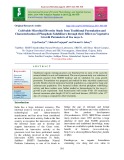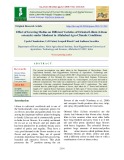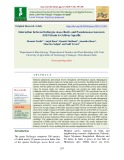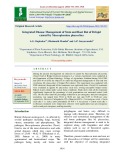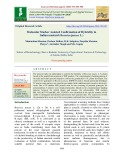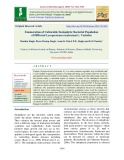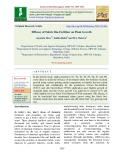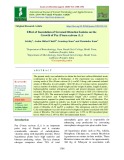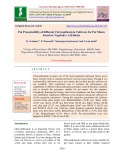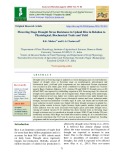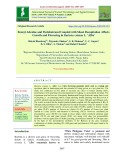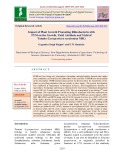
Presentable pot plant
-
The present study was conducted under the pot condition. Pot experiment was laid out in Completely Randomized Design (CRD) with three replications at research field of the Department of Plant Pathology, Sam Higginbottom University of Agriculture, Technology and Science, during the Rabi season of 2019-20.
 9p
9p  trinhthamhodang11
trinhthamhodang11
 27-04-2021
27-04-2021
 8
8
 1
1
 Download
Download
-
The present investigation was aimed at determining the effects of vesicular arbuscular mycorrhiza (VAM) on vegetative growth of chrysanthemum var. Marigold plants grown under salinity condition. Entrophospora sp. (VAM) inoculated plants of forty-five days old seedlings (DAS) were transplanted into pots (one seedling per pot) until the flowering. After (75 days) transplanting, seedlings of chrysanthemum var
 6p
6p  cothumenhmong9
cothumenhmong9
 04-01-2021
04-01-2021
 4
4
 2
2
 Download
Download
-
The present studies were carried out under laboratory and pot conditions at during kharif season of 2017-18, at Department of Plant Protection, Faculty of Agricultural Sciences, Aligarh Muslim University, Aligarh, Uttar Pradesh (India).
 6p
6p  nguaconbaynhay7
nguaconbaynhay7
 15-08-2020
15-08-2020
 13
13
 1
1
 Download
Download
-
Cassava (Manihot esculenta Crantz.) is an important tuber cultivated in India. Cassava is vegetatively propagated through stem cuttings (setts). A mature plant with two stems will give about 12 to 20 normal sized (20 cm) setts after one year. Farmers are practicing 8-10 cm long cuttings from the mature part of stem and planted in vertical position in nursery bed at closer spacing of 5 cm. Under conventional system of propagation, 1250 to 1500 stems are required for planting one hectare of area.
 5p
5p  caygaocaolon6
caygaocaolon6
 30-07-2020
30-07-2020
 6
6
 1
1
 Download
Download
-
In this present studied poly bag experiment was conducted following complete randomized block design with 12 treatments and three replications. Polluted Soil with supply of fresh water, Unpolluted soil with supply of fresh water, Unpolluted soil with supply of polluted water. The results of pot culture were reveals that the Nitrogen availability was highest in T3 (140.65kgha-1 ) and lowest in T8 (116.79kgha-1 ) at harvesting stage, phosphorus uptake was found in the treatment T3 (43.
 8p
8p  angicungduoc6
angicungduoc6
 20-07-2020
20-07-2020
 13
13
 3
3
 Download
Download
-
Traditional organic farming practices are beneficial but in most of the cases the science behind it is not well understood. The aim of present study was selection of grassroots practice from SRISTI database and its validation for crops growth promotion. Formulation was prepared and studied for their microbial content and growth. Results showed maximum bacterial population as compared to fungi and actinomycetes population. Five bacterial isolates showed phosphate solubilizing activity and these isolates were further studied as bioinoculants for Zea mays L. growth in pot experiment.
 10p
10p  kethamoi6
kethamoi6
 29-06-2020
29-06-2020
 12
12
 1
1
 Download
Download
-
The present investigation was under taken in the Department of Horticulture, Naini Agricultural Institute, Sam Higginbottom University of Agriculture, Technology and Sciences, Allahabad during rabi season (2016-2017). Experiment was carried out to assess the performance of five Oriental lily varieties viz., Cobra Red, Signum, Yelloween, Sorbonne and Justina grown in different media viz. vermicompost, coco peat and sand in different compositions. The study was conducted as a pot culture trial in form of factorial experiment following completely Randomized Design with 3 replications.
 8p
8p  quenchua6
quenchua6
 15-06-2020
15-06-2020
 16
16
 2
2
 Download
Download
-
In present study, pot culture experiment was carried out under glass house conditions with two Dalbergia sissoo cultivars PS90 and PS52. The experiment was set in a completely randomized block design (CRD) and consisted of six treatments including controls with three replications in each treatment. During experiment seven day old seedlings of D. sissoo cultivars germinated from freshly collected seeds and subsequently treated with Pseudomonas koreensis AS15 strain by root dip method were planted in 1kg capacity plastic pots.
 10p
10p  nguathienthan5
nguathienthan5
 04-06-2020
04-06-2020
 16
16
 1
1
 Download
Download
-
During the present investigations on charcoal rot caused by Macrophomina phaseolina (Tassi) Goid of Brinjal (Solanum melongena L.), various experiments were conducted at the Department of Plant Pathology, College of Agriculture, Parbhani during 2014-2015 and 2015-16 to fulfill the objective to study the integrated management of stem and root rot disease (M. phaseolina) of brinjal (Pot culture).
 5p
5p  trinhthamhodang1213
trinhthamhodang1213
 02-06-2020
02-06-2020
 10
10
 0
0
 Download
Download
-
The present study was undertaken to confirm the hybridity of Brassica juncea L. F1 plants based on the amplification pattern of SSR markers. The complementary banding pattern of the male and female parents helped to confirm the genuineness of F1 plants developed. The seeds of two genotypes of Brassica juncea, RSPR-01 used as female parent and DonskajaIV used as male parent were raised in pots under field conditions and crossed to develop F1 seeds. Out of 20 random SSR primers used for the screening of parental genotypes for polymorphism, 5 primers were found polymorphic.
 7p
7p  trinhthamhodang1213
trinhthamhodang1213
 30-05-2020
30-05-2020
 7
7
 0
0
 Download
Download
-
In the present study Bovine digesta, a major slaughter house waste has been recycled as organic fertilizer. Bovine digesta collected was sun dried for 3 days, powdered and was subjected to physicochemical analysis - BOD, COD, pH and TDS. Bovine digesta has 1.35% Nitrogen, 0.72% Phosphorous and 0.515% Potassium. Hence, it has been evaluated as organic fertilizer in Maize at various percentages like 75%, 100%, 125% and 150% equated with nitrogen content of urea. Urea and farmyard manure has been used as inorganic and organic fertilizer control for Bovine digesta.
 11p
11p  nguaconbaynhay5
nguaconbaynhay5
 16-05-2020
16-05-2020
 12
12
 1
1
 Download
Download
-
Tomato (Lycopersicum esculentum L.), is a most common vegetable crop worldwide and is well studied in genetics, genomics, breeding and being an excellent model for the basic and applied research related to fruit quality, stress tolerance and other physiologic traits. In the present study, a microbial aspect of tomato, in terms of the endophytic bacterial population present in the plant had been studied.
 9p
9p  kethamoi4
kethamoi4
 16-04-2020
16-04-2020
 10
10
 1
1
 Download
Download
-
In the present study, eight treatments (T1, T2, T3, T4, T5, T6, T7, and T8) were taken to study the efficacy of developed fabric bio-fertilizer on plant growth using various potting media components to identify the best suited component and combination for the production. Cotton bio-fertilizer (T3C3) and silk bio-fertilizer (T5S2) application gave highest growth of marigold plant and the lowest growth was achieved in control (T7) and while slightly lower in Farm Yard Manure (FYM) treatment (T8).
 15p
15p  trinhthamhodang1212
trinhthamhodang1212
 06-04-2020
06-04-2020
 15
15
 1
1
 Download
Download
-
The present study was undertaken to obtain the best host cultivar-Rhizobial strain combination in the soils of Hoshiarpur. A Pot experiment was conducted by sowing seeds of Pea (Pisum sativum (L.)) varAP-3 along with screened isolated strains of Rhizobia in soil samples. After 60 days of sowing various parameters such as number of nodules, fresh weight and dry weight of plants, length of plants, leghaemoglobin content, nitrogenase activity and percent nitrogen content were recorded.
 5p
5p  caygaocaolon4
caygaocaolon4
 04-04-2020
04-04-2020
 11
11
 0
0
 Download
Download
-
Chrysanthemum occupies one of the most important traditional flower and a place of pride, both as commercial flower crop and as pot plant. Though it is a commercially cultivated crop in our country, the location specific cultivars are not available. This experiment was to evaluate the performance and adaptability of different chrysanthemum genotypes under Hyderabad condition and to identify the genotypes suitable for pot mums. For this purpose, Completely Randomised Design with twelve treatments and three replications was established.
 4p
4p  trinhthamhodang4
trinhthamhodang4
 22-03-2020
22-03-2020
 7
7
 2
2
 Download
Download
-
Drought stress at flowering stage in upland rice is most damaging cause of yield reduction. Impact of drought stress at flowering stage on morphological, physiological and biochemical traits, yield and yield components are less understood. Present experiment was executed in pots under glass house conditions by taking six upland rice varieties namely Bagri, Nankawa, Bakaiya, N-22, Ashoka-228 and NDR-97.
 12p
12p  cothumenhmong4
cothumenhmong4
 25-03-2020
25-03-2020
 15
15
 2
2
 Download
Download
-
Barleria cristata L. ‘Alba’ is a white flowering perennial shrub used as a hedge and specimen plant in landscaping and has potential of being grown as a pot plant too. The study was conducted on this plant to ascertain the effect of benzyl adenine (BA), paclobutrazol with pinching (shoot decapitation) for making it a presentable pot plant.
 11p
11p  chauchaungayxua4
chauchaungayxua4
 18-03-2020
18-03-2020
 22
22
 2
2
 Download
Download
-
Rhizoctonia solani causing sheath blight of rice is reported to survive through soil and collateral hosts. Although it infects seed in field, role of seed-borne inoculum in disease development is not properly understood. However, only little information is available on the role of seed-borne inoculum in disease development in the field (Roy, 1989; Acharya and Gupta, 1996; Silvalingam et al., 2006). During the present investigation seed samples of two varieties were collected from healthy seeds (i.e. seeds harvested from healthy plant panicles) and diseased seeds (i.e.
 14p
14p  caygaocaolon2
caygaocaolon2
 14-03-2020
14-03-2020
 9
9
 0
0
 Download
Download
-
PGPB are free-living soil, rhizosphere, rhizoplane, and phylosphere bacteria that, under some conditions, are beneficial for plants Most of the activities of PGPB have been studied in the rhizosphere. PGPB promote plant growth by directly affect the metabolism of the plants by providing substances that are usually in short supply. The present investigation was conducted at Department of Biological Sciences, Sam Higginbottom Institute of Agriculture, Technology and Sciences (Deemed-to-be University) Allahabad, during Rabi season 2015-16.
 14p
14p  caygaocaolon3
caygaocaolon3
 09-03-2020
09-03-2020
 15
15
 0
0
 Download
Download
-
Rhizobacterial strains having plant growth promoting hormone can helps in promoting plant growth and mitigates adverse conditions. Keeping in view of their positive impact, present study was undertaken to identify the Salt Tolerant Rhizobacteria (STR) having IAA production activity. Out of 300 bacteria from the mustard rhizospheric soil 25 could able to grow at 10% NaCl medium termed as STR were assessed for their plant growth promoting hormones. Bacterial strains (STR PGP) B1, B14, B17 and B25 identified as genus Enterobacter showing IAA production ranges from 1 - 3 µg/ml.
 7p
7p  trinhthamhodang3
trinhthamhodang3
 22-02-2020
22-02-2020
 31
31
 0
0
 Download
Download
CHỦ ĐỀ BẠN MUỐN TÌM









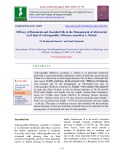
![Efficacy of Entrophospora sp. (VA Mycorrhiza) on salt tolerance and vegetative growth of Chrysanthemum var. Marigold [Dendranthema grandiflora Tzvelev.] Efficacy of Entrophospora sp. (VA Mycorrhiza) on salt tolerance and vegetative growth of Chrysanthemum var. Marigold [Dendranthema grandiflora Tzvelev.]](https://tailieu.vn/image/document/thumbnail/2021/20210104/cothumenhmong9/135x160/5841609772176.jpg)



